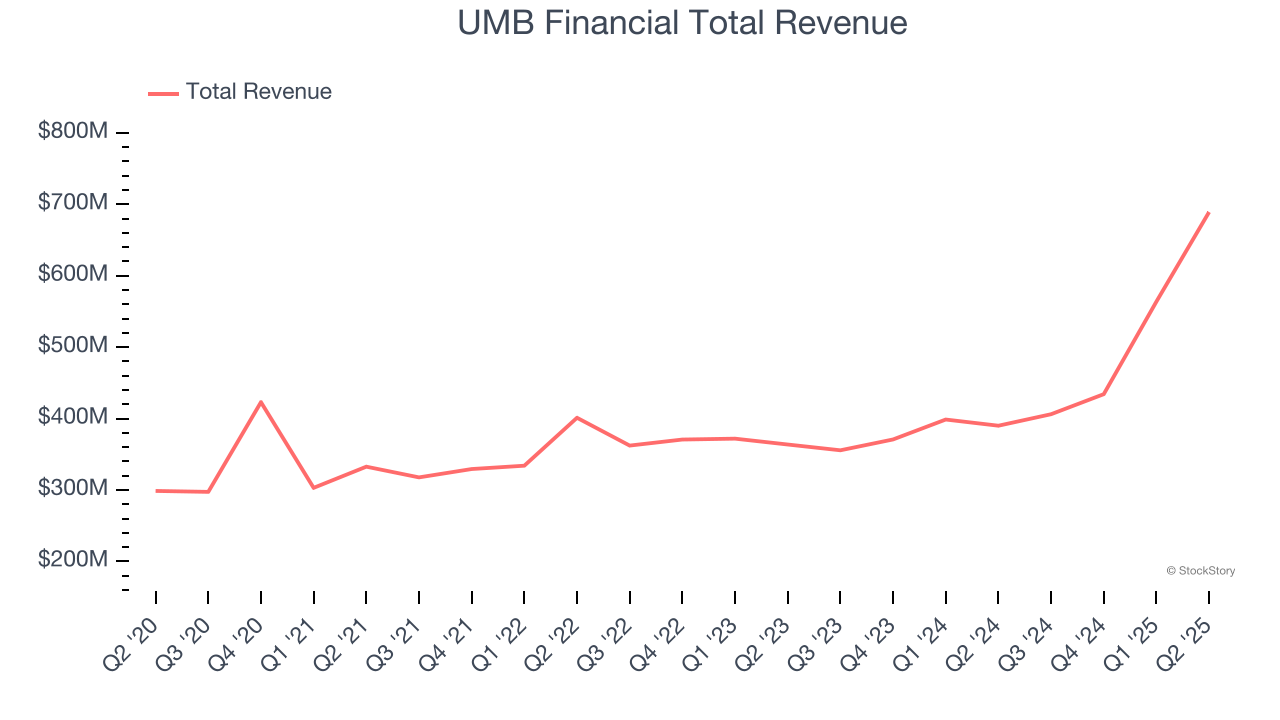
Looking back on regional banks stocks’ Q2 earnings, we examine this quarter’s best and worst performers, including Popular (NASDAQ: BPOP) and its peers.
Regional banks, financial institutions operating within specific geographic areas, serve as intermediaries between local depositors and borrowers. They benefit from rising interest rates that improve net interest margins (the difference between loan yields and deposit costs), digital transformation reducing operational expenses, and local economic growth driving loan demand. However, these banks face headwinds from fintech competition, deposit outflows to higher-yielding alternatives, credit deterioration (increasing loan defaults) during economic slowdowns, and regulatory compliance costs. Recent concerns about regional bank stability following high-profile failures and significant commercial real estate exposure present additional challenges.
The 103 regional banks stocks we track reported a satisfactory Q2. As a group, revenues were in line with analysts’ consensus estimates.
In light of this news, share prices of the companies have held steady as they are up 1.1% on average since the latest earnings results.
Popular (NASDAQ: BPOP)
Founded in 1893 as the first bank in Puerto Rico to serve the working class, Popular (NASDAQ: BPOP) is a financial holding company that provides retail, mortgage, and commercial banking services primarily in Puerto Rico and the mainland United States.
Popular reported revenues of $800 million, up 9% year on year. This print exceeded analysts’ expectations by 3.5%. Overall, it was an exceptional quarter for the company with a beat of analysts’ EPS and net interest income estimates.
“We delivered strong performance in the second quarter, highlighted by higher net interest income, an expanding net interest margin, healthy loan and deposit growth, and improved credit quality,” said Javier D. Ferrer, President and Chief Executive Officer of Popular, Inc.

Interestingly, the stock is up 10.5% since reporting and currently trades at $127.33.
Read why we think that Popular is one of the best regional banks stocks, our full report is free.
Best Q2: UMB Financial (NASDAQ: UMBF)
With roots dating back to 1913 and a name derived from "United Missouri Bank," UMB Financial (NASDAQ: UMBF) is a financial holding company that provides banking, asset management, and fund services to commercial, institutional, and individual customers.
UMB Financial reported revenues of $689.2 million, up 76.7% year on year, outperforming analysts’ expectations by 8.6%. The business had a stunning quarter with a beat of analysts’ EPS estimates and an impressive beat of analysts’ tangible book value per share estimates.

The market seems happy with the results as the stock is up 8% since reporting. It currently trades at $118.49.
Is now the time to buy UMB Financial? Access our full analysis of the earnings results here, it’s free.
Weakest Q2: Coastal Financial (NASDAQ: CCB)
Pioneering the intersection of traditional banking and financial technology in the Pacific Northwest, Coastal Financial (NASDAQ: CCB) operates as a bank holding company that provides traditional banking services and Banking-as-a-Service (BaaS) solutions to consumers and businesses.
Coastal Financial reported revenues of $119.4 million, down 11.7% year on year, falling short of analysts’ expectations by 21.5%. It was a disappointing quarter as it posted a significant miss of analysts’ net interest income and EPS estimates.
Interestingly, the stock is up 15.1% since the results and currently trades at $116.80.
Read our full analysis of Coastal Financial’s results here.
Merchants Bancorp (NASDAQ: MBIN)
With a strategic focus on low-risk, government-backed lending programs, Merchants Bancorp (NASDAQCM:MBIN) is an Indiana-based bank holding company specializing in multi-family mortgage banking, mortgage warehousing, and traditional banking services.
Merchants Bancorp reported revenues of $179.2 million, up 12.4% year on year. This print topped analysts’ expectations by 12.5%. More broadly, it was a slower quarter as it produced a significant miss of analysts’ EPS and net interest income estimates.
Merchants Bancorp delivered the biggest analyst estimates beat among its peers. The stock is down 8.8% since reporting and currently trades at $32.03.
Read our full, actionable report on Merchants Bancorp here, it’s free.
Butterfield Bank (NYSE: NTB)
Founded in 1784 as one of the oldest banks in the Western Hemisphere, Butterfield Bank (NYSE: NTB) provides banking, wealth management, and trust services to individuals and businesses in select offshore financial centers including Bermuda, Cayman Islands, and the Channel Islands.
Butterfield Bank reported revenues of $146.5 million, up 2.4% year on year. This number came in 0.7% below analysts' expectations. Overall, it was a slower quarter as it also produced a narrow beat of analysts’ EPS estimates and net interest income in line with analysts’ estimates.
The stock is down 3.6% since reporting and currently trades at $42.90.
Read our full, actionable report on Butterfield Bank here, it’s free.
Market Update
Thanks to the Fed’s rate hikes in 2022 and 2023, inflation has been on a steady path downward, easing back toward that 2% sweet spot. Fortunately (miraculously to some), all this tightening didn’t send the economy tumbling into a recession, so here we are, cautiously celebrating a soft landing. The cherry on top? Recent rate cuts (half a point in September 2024, a quarter in November) have propped up markets, especially after Trump’s November win lit a fire under major indices and sent them to all-time highs. However, there’s still plenty to ponder — tariffs, corporate tax cuts, and what 2025 might hold for the economy.
Want to invest in winners with rock-solid fundamentals? Check out our Hidden Gem Stocks and add them to your watchlist. These companies are poised for growth regardless of the political or macroeconomic climate.
StockStory is growing and hiring equity analyst and marketing roles. Are you a 0 to 1 builder passionate about the markets and AI? See the open roles here.





